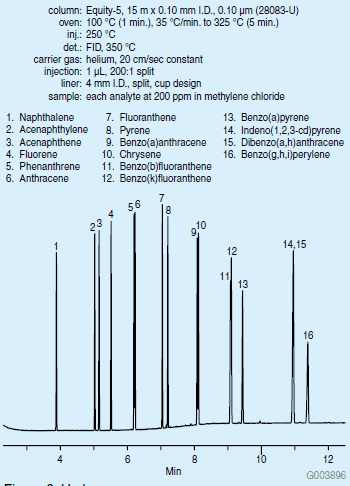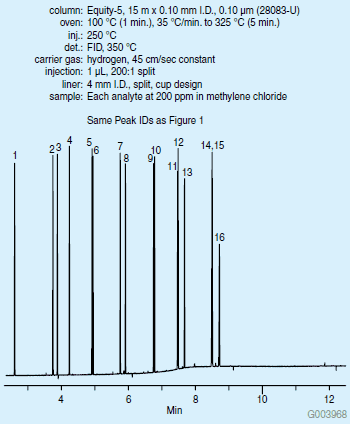Hydrogen: A Carrier Gas Alternative to Helium
Introduction
Carrier gas for gas chromatography (GC) should be an inert gas that does not react with the sample component. Its main role is to transport the vaporized solute molecules through the column. The selection of the carrier gas and the linear velocity it uses both affect resolution and retention times.
Nitrogen, hydrogen, and helium are the most widely used gases by today’s chromatographer. Each has unique benefits as well as drawbacks. Nitrogen shows the best efficiency, but over a low and narrow linear velocity range. Therefore, it is extremely slow as a carrier gas, and not a great choice for temperature-programmed use. Hydrogen provides the fastest analysis time over a broad linear velocity range. However, safety concerns must be addressed. Helium is a compromise between nitrogen and hydrogen, with regards to efficiency and analysis times. However, it is becoming an expensive choice for a carrier gas.Let’s take a look and compare the advantages of using hydrogen over helium.
Benefits of Hydrogen as a Carrier Gas: Speed 1
The Golay Theory for open tubular columns predicts that optimum gas velocity is proportional to diffusivity. Hydrogen has a higher diffusivity than helium, thus its optimum linear velocity is higher and can be used at a higher flow rate without adversely affecting efficiency. Specifically, under isothermal analysis conditions, the typical linear velocity for hydrogen is 40 cm/sec, which is twice the optimum linear velocity of helium at 20 cm/sec. Therefore, simply switching to hydrogen carrier gas, even while keeping column dimensions and oven conditions constant, can be expected to decrease analysis time.
Figures 1 and 2 illustrate this benefit of hydrogen with the separation of 16 commonly analyzed polynuclear aromatic hydrocarbons. The analysis was performed on a 15 m x 0.10 mm I.D., 0.10 μm Equity®-5 column. A fast temperature-programming rate was used to decrease the run time to less than 12 minutes using helium at its optimal linear velocity. Switching to hydrogen carrier gas (at its optimal linear velocity) under the same conditions resulted in a 25% decrease in run time.

Figure 1.Helium (28083-U)

Figure 2.Hydrogen (28083-U)
Benefits of Hydrogen as a Carrier Gas: Speed 2
What if carrier gas is run at higher than optimal linear velocity to decrease analysis times? Hydrogen, having a flatter Golay curve, may be operated over a wide range of linear velocities while maintaining a low height equivalent to a theoretical plate (HETP). This allows the use of a linear velocity higher than optimal with little decrease in efficiency, resulting in shorter analysis times.
Benefits of Hydrogen as a Carrier Gas: Cost 1
A shortage of helium began surfacing in 2006. Helium must be extracted from the ground and then refined. However, there are not enough refineries to keep up with the increased demand, such as for applications in the medical, scientific, and industrial fields. As a result, helium is becoming a rare commodity with rising prices. Hydrogen has not seen a drastic rise in price because its production is not dependent on the same factors.
Benefits of Hydrogen as a Carrier Gas: Cost 2/Safety
Because helium generators are not available, it can only be obtained in expensive cylinders. Hydrogen is also available in cylinders, but can also be generated ondemand on-site using a gas generator. In addition to being a much more sensible source of gas from a cost standpoint, generators are safer, more aesthetically pleasing, take up less space, and do not require the labor needed to move bulky cylinders around the lab. The safety benefit of a hydrogen generator over a cylinder is due to the fact that a minimal volume of hydrogen gas is stored at a relatively low pressure.
Conclusion
Hydrogen has several features (higher optimal linear velocity, and flatter Golay curve) that result in desirable benefits (decreased analysis times) when compared to other GC carrier gas choices. If operating exactly at optimal linear velocities, hydrogen results in a faster analysis time. Because hydrogen has the flattest Golay curve, the GC can be operated with an even higher linear velocity without a significant loss in efficiency. As long as the proper safety controls are in place, hydrogen, with its broad working range, may be a more suitable carrier gas choice for capillary GC.
References
To continue reading please sign in or create an account.
Don't Have An Account?